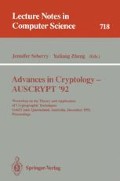Abstract
In this paper, the evaluation of \(\prod\nolimits_{i = 1}^p {M_i^{b_i } }\) considered and a fast algorithm is proposed. Through out this paper, the above evaluation is called the cascade exponentiation. The cases of P=1, P=2, and P=3 of the cascade exponentiations have special importance in cryptographic applications. The performance analysis and comparisons of the proposed algorithm and the best known method will be given.
Preview
Unable to display preview. Download preview PDF.
References
T. ElGamal, ”A public key cryptosystem and signature scheme based on discrete logarithms,” IEEE Trans. on Inform. Theory, Vol. IT-31, No. 4, pp.469–472, July 1985.
R.L. Rivest, A. Shamir, and L. Adleman, ”A method for obtaining digital signatures and public-key cryptosystem,” Commun. ACM, Vol. 21, pp.120–126, Feb. 1978.
D.E. Knuth, The art of computer programming, Vol. II: Seminumerical algorithms. Reading, Addison Wesley, 1969.
Andrew Yao, ”On the evaluation of powers,” Siam. J. Comput. 5, (1976).
P. Downey B. Leony and R. Sethi, ”Computing sequences with addition chains,” Siam Journ. Comput. 3 (1981) pp.638–696.
J. Bos, M. Coster, ”Addition Chain Heuristics,” Proceedings CRYPTO'89, Springer-Verlag Lecture Notes in Computer Science, pp.400–407.
W. Diffie and M.E, Hellman, ”New directions in cryptography,” IEEE Trans. on Inform. Theory, vol.IT-22, pp.644–654, 1976.
C.P. Schnorr, ”Efficient identification and signatures for smart cards,” Advances in Cryptology-Proceedings of Crypto'89, Lecture Notes in Computer Science, Vol.435, Springer Verlag, New York, 1990, pp.239–252.
E.F. Brickell and K.S. McCurley, ”Interactive identification and digital signatures,” AT and T Technical Journal, November/December 1991, pp.73–86.
”A Proposed Federal Information Processing Standard for Digital Signature Standard (DSS),” Federal Register, Vol.56, No.169, August 31, 1991, pp.42980–42982.
Y. Yacobi, ”Exponentiating faster with addition chains,” Advances in Cryptology-Proceedings of Eurocrypt'90, pp.205–212, 1990.
C.S. Laih and S.M. Yen, ”The Study of Fast Exponentiation Algorithm,” Technical Report of NSC 81-0408-E-006-02 (1992).
Author information
Authors and Affiliations
Editor information
Rights and permissions
Copyright information
© 1993 Springer-Verlag Berlin Heidelberg
About this paper
Cite this paper
Yen, SM., Laih, CS. (1993). The fast cascade exponentiation algorithm and its applications on cryptography. In: Seberry, J., Zheng, Y. (eds) Advances in Cryptology — AUSCRYPT '92. AUSCRYPT 1992. Lecture Notes in Computer Science, vol 718. Springer, Berlin, Heidelberg. https://doi.org/10.1007/3-540-57220-1_82
Download citation
DOI: https://doi.org/10.1007/3-540-57220-1_82
Published:
Publisher Name: Springer, Berlin, Heidelberg
Print ISBN: 978-3-540-57220-6
Online ISBN: 978-3-540-47976-5
eBook Packages: Springer Book Archive

